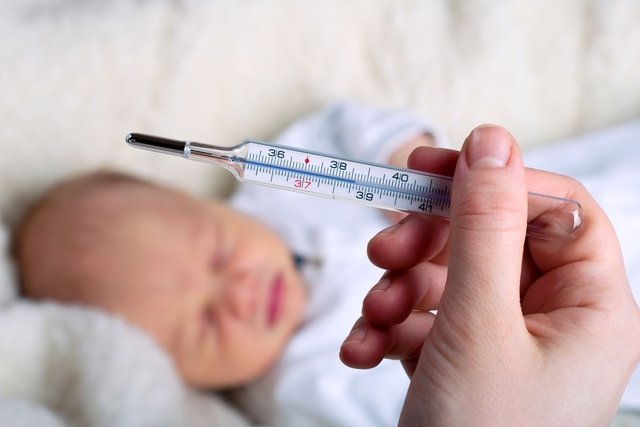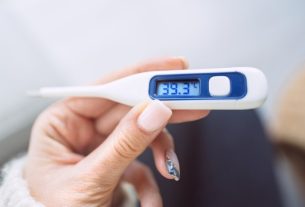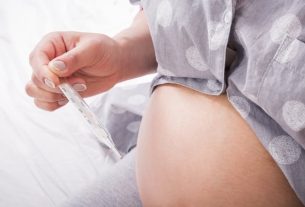An increase in the baby’s body temperature should only be considered a fever when it exceeds 37.5ºC in an armpit measurement, or 38.2ºC in the rectum. Before this temperature, it is only considered to be a fever, which is generally not a cause for concern.
Whenever the baby has a fever, you should check whether he or she has other symptoms because, normally, teething and receiving a vaccine can cause a fever of up to 38ºC, but the baby continues to eat and sleep well. In this case, placing a washcloth dipped in cold water on the baby’s forehead can help reduce the fever.
Although a baby’s fever is considered to be above 37.5ºC, in the armpit, or 38.2ºC, in the rectum, it is generally only likely to cause brain damage when it exceeds 41.5ºC or more.
What can cause a baby to have a fever?
An increase in body temperature indicates that the baby’s body is fighting against an invading agent. The most common situations that cause fever in babies are:
- Emergence of teeth: It usually happens from the 4th month onwards and you can see swollen gums and the baby always wants to have his hand in his mouth, in addition to drooling a lot.
- Reaction after taking a vaccine: It appears a few hours after taking the vaccine, making it easy to relate that the fever is probably a reaction
- If the fever comes on after a cold or flu, it may be suspected. sinusitis or ear inflammation: The baby may not have phlegm or appear to have a cold, but the tissues inside the nose and throat may be inflamed, causing a fever.
- Pneumonia: Flu symptoms become more intense and fever appears, making it more difficult for the baby to breathe;
- Urinary infection: Low fever (up to 38.5ºC measured at the anus) may be the only sign in children under 2 years of age, but vomiting and diarrhea, abdominal pain and loss of appetite may appear.
- Dengue: more common in summer, especially in epidemic areas, there is fever and loss of appetite, the child becomes cunning and likes to sleep a lot.
- Chickenpox: There is fever and itchy skin blisters, loss of appetite and abdominal pain may also appear.
- Measles: The fever lasts 3 to 5 days, and there are usually signs of coughing, runny nose and conjunctivitis, as well as dark spots on the skin.
- Scarlet fever: There is a fever and sore throat, the tongue becomes swollen and looks like a raspberry, small spots appear on the skin that can cause peeling.
- Erysipelas: There is fever, chills, pain in the affected area, which may become red and swollen.
If you suspect that your baby has a fever, you should measure the fever with a thermometer, and observe whether there are other signs or symptoms that could help identify what is causing the fever, but in case of doubt, you should go to the pediatrician, especially when the baby is less than 3 months old.
How to measure a baby’s fever
To measure a baby’s fever, place the metal tip of the glass thermometer under the baby’s arm, leaving it there for at least 3 minutes, and then check the temperature on the thermometer itself. Another possibility is to use a digital thermometer, which shows the temperature in less than 1 minute.
The temperature can also be measured more accurately in the baby’s rectum. However, in these cases, it is important to take into account that the rectal temperature is higher than the oral temperature and the axillary temperature, so when checking the temperature, it should always be checked in the same place, the most common being the armpit. The rectal temperature can be between 0.8 and 1ºC higher than the axillary temperature, and therefore when the baby has a fever of 37.8ºC in the armpit, he probably has a temperature of 38.8ºC in the anus.
To measure the temperature in the rectum, it is mandatory to use a thermometer with a soft and flexible bridge that must be inserted at least 3 cm
See more about how to use the thermometer correctly.
Tips to lower baby’s fever
What is recommended to do to reduce your baby’s fever is:
- Check whether the environment is too hot and, if possible, turn on a fan or air conditioning;
- Change the baby’s clothes to lighter and cooler ones;
- Offer the baby something liquid and cool to drink every half hour, if he is awake;
- Give the baby a warm to cold bath, avoiding very cold water. The water temperature should be as close to 36ºC, which is normal skin temperature.
- Placing a washcloth dipped in warm to cold water on the baby’s forehead can also help reduce the fever.
If the fever does not subside within half an hour, a doctor should be consulted, especially if the baby is very irritable, cries a lot or is lethargic. The medicine recommended to reduce fever in babies is Dipirone, but it should only be used with the pediatrician’s knowledge.
Check out other options to lower your baby’s fever.
How to know if a fever is serious
Fever is always serious when it reaches 38ºC, requiring the full attention of parents and a visit to the pediatrician, especially when:
- It is not possible to identify that the teeth are coming in and that there is probably another cause;
- There is diarrhea, vomiting and the child does not want to breastfeed or eat;
- The child has sunken eyes, is more tearful than normal, and pees little, as this may indicate dehydration;
- Spots appear on the skin, itchiness or if the baby seems very uncomfortable.
But if the baby is just soft and drowsy, but has a fever, you should also go to the pediatrician to find out what is causing this increase in temperature and start appropriate treatment, with medication.





